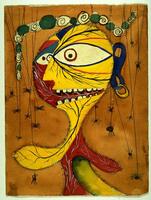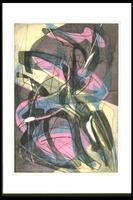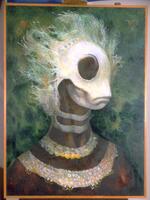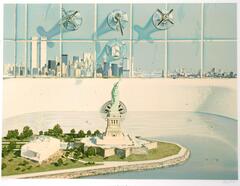Explore this collection for warm pieces, reminiscent of the autumn season.
20 Items in this Learning Collection
Collection Object
Collection Object
Collection Object
Collection Object
Collection Object
Collection Object
Collection Object
Collection Object
Collection Object
Collection Object
Collection Object
Collection Object
Collection Object
Collection Object
Collection Object
Collection Object
Collection Object
Copyright
All Rights Reserved
()
At the Crossroads (En Rade)
Accession Number
1983/1.414
Title
At the Crossroads (En Rade)
Artist(s)
Max Ernst
Artist Nationality
German (culture or style)
Object Creation Date
1955
Medium & Support
oil on canvas
Dimensions
19 1/2 x 22 15/16 x 1 in. (49.53 x 58.26 x 2.54 cm);19 1/2 x 22 15/16 x 1 in. (49.53 x 58.26 x 2.54 cm);14 7/8 x 18 1/4 in. (37.7 x 46.2 cm)
Credit Line
Gift of the Estate of Maxine W. Kunstadter in memory of Sigmund Kunstadter, Class of 1922
Label copy
March 28, 2009
The controlled geometric style and luminous palette of At the Crossroads corresponds to the period when Ernst lived in Sedona, Arizona (1946–1950). Whereas many of his Surrealist paintings are hallucinatory in their quantity of minute detail, this one employs an elementary pictorial vocabulary of rectilinear planes and lines. Upon close inspection, it reveals an extraordinarily complex structure: the space of the canvas is not only fractured, but the layering of tone-on-tone color gives a countervailing sense of depth. At the same time the highly stylized liner forms of the birds, which are also outlines of three particular groupings of shapes, reassert the flatness of the picture, so that there is a constant shift between surface and depth.
Max Ernst was something of an ambassador for Surrealism. He was a founding member of the Surrealist group in Paris, and among those who escaped to New York as city after city in Europe fell to Hitler’s army. At the time he was married to Peggy Guggenheim, whose gallery Art of This Century (1942–1946) was a hub of avant-garde activity. Ernst’s Surrealist works, steeped in Freudian metaphors, private mythology, and childhood memories, were among the paintings on view at the gallery that had a profound impact on the direction Abstract Expressionism would take in the second half of the 1940s.
Subject matter
With its radiant palette of gold and trio of birds, this work suggests an evolution or transformation
Physical Description
Three birds, executed with spare line and simple form, are set within an abstracted landscape of bright yellows and oranges.
Primary Object Classification
Painting
Primary Object Type
abstract
Collection Area
Western
Rights
If you are interested in using an image for a publication, please visit http://umma.umich.edu/request-image for more information and to fill out the online Image Rights and Reproductions Request Form.
Keywords
Abstract (fine arts style)
Birds
Surrealism
Surrealist
abstraction
modern and contemporary art
oil painting (technique)
sky
sunlight
1983/1.414
Title
At the Crossroads (En Rade)
Artist(s)
Max Ernst
Artist Nationality
German (culture or style)
Object Creation Date
1955
Medium & Support
oil on canvas
Dimensions
19 1/2 x 22 15/16 x 1 in. (49.53 x 58.26 x 2.54 cm);19 1/2 x 22 15/16 x 1 in. (49.53 x 58.26 x 2.54 cm);14 7/8 x 18 1/4 in. (37.7 x 46.2 cm)
Credit Line
Gift of the Estate of Maxine W. Kunstadter in memory of Sigmund Kunstadter, Class of 1922
Label copy
March 28, 2009
The controlled geometric style and luminous palette of At the Crossroads corresponds to the period when Ernst lived in Sedona, Arizona (1946–1950). Whereas many of his Surrealist paintings are hallucinatory in their quantity of minute detail, this one employs an elementary pictorial vocabulary of rectilinear planes and lines. Upon close inspection, it reveals an extraordinarily complex structure: the space of the canvas is not only fractured, but the layering of tone-on-tone color gives a countervailing sense of depth. At the same time the highly stylized liner forms of the birds, which are also outlines of three particular groupings of shapes, reassert the flatness of the picture, so that there is a constant shift between surface and depth.
Max Ernst was something of an ambassador for Surrealism. He was a founding member of the Surrealist group in Paris, and among those who escaped to New York as city after city in Europe fell to Hitler’s army. At the time he was married to Peggy Guggenheim, whose gallery Art of This Century (1942–1946) was a hub of avant-garde activity. Ernst’s Surrealist works, steeped in Freudian metaphors, private mythology, and childhood memories, were among the paintings on view at the gallery that had a profound impact on the direction Abstract Expressionism would take in the second half of the 1940s.
Subject matter
With its radiant palette of gold and trio of birds, this work suggests an evolution or transformation
Physical Description
Three birds, executed with spare line and simple form, are set within an abstracted landscape of bright yellows and oranges.
Primary Object Classification
Painting
Primary Object Type
abstract
Collection Area
Western
Rights
If you are interested in using an image for a publication, please visit http://umma.umich.edu/request-image for more information and to fill out the online Image Rights and Reproductions Request Form.
Keywords
Abstract (fine arts style)
Birds
Surrealism
Surrealist
abstraction
modern and contemporary art
oil painting (technique)
sky
sunlight
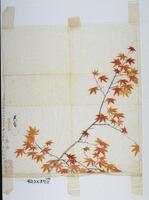
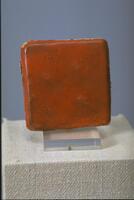
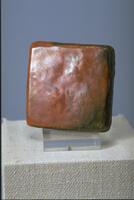

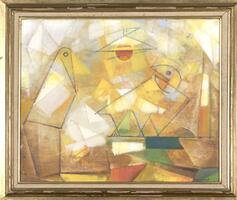
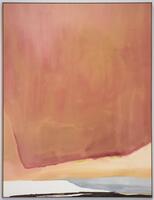
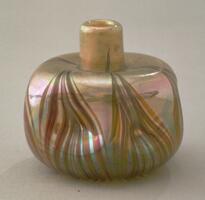


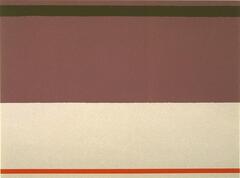
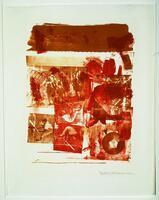
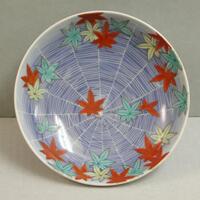

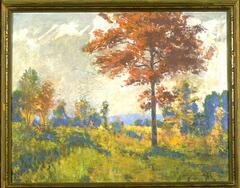
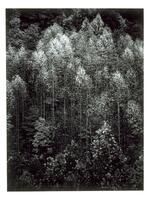
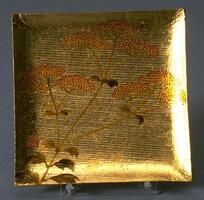

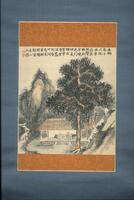
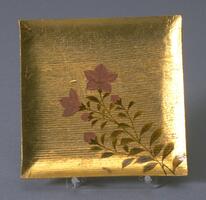
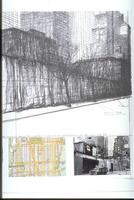
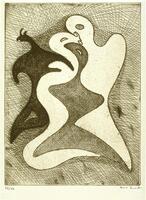
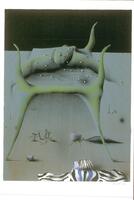
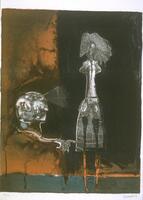

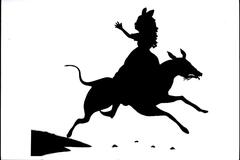

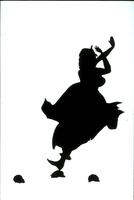

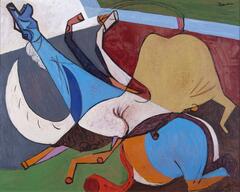
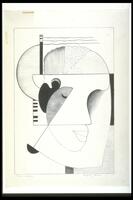
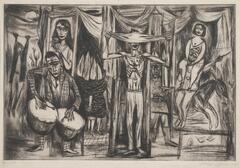

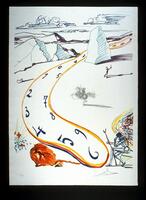
![In this mixed-media print, there is a white background with black outlines of facial features, lips and an eye, and a creature in the bottom left. In the upper left corner there is a rectanglular sheet in cream layered on top; a wavy vertical design stretches diagonally from the top of the rectangle to the bottom in yellow, red, and blue. Within this sheet, there are small figures at the center left drawn in black. To the right in the sheet, there is a collaged image of one of the artist's paintings, incorporated into a cube. Above, there are drawn birds. There is a small mechanical-like figure on the sheet at the bottom left. At the center of the print, in the cream page, the artist signed "Dali" and dated the print "1975. To the bottom left, on the larger white page, there is text inscribed in the plate, mirrored and someone illegible, that possibly reads "Leill Ciclopeer Alucire la bouche Almient tire / Lula [illegible]." The print is number at the lower left in pencil. In this mixed-media print, there is a white background with black outlines of facial features, lips and an eye, and a creature in the bottom left. In the upper left corner there is a rectanglular sheet in cream layered on top; a wavy vertical design stretches diagonally from the top of the rectangle to the bottom in yellow, red, and blue. Within this sheet, there are small figures at the center left drawn in black. To the right in the sheet, there is a collaged image of one of the artist's paintings, incorporated into a cube. Above, there are drawn birds. There is a small mechanical-like figure on the sheet at the bottom left. At the center of the print, in the cream page, the artist signed "Dali" and dated the print "1975. To the bottom left, on the larger white page, there is text inscribed in the plate, mirrored and someone illegible, that possibly reads "Leill Ciclopeer Alucire la bouche Almient tire / Lula [illegible]." The print is number at the lower left in pencil.](/media/W1siZiIsIjIwMjIvMDUvMjUvMWUwenVmM3Nlel9kZWZhdWx0LmpwZyJdLFsicCIsInRodW1iIiwiMjQweDIwMCJdXQ?sha=03c3865ec6fdec9d)
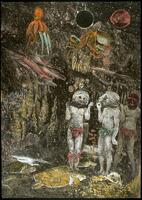
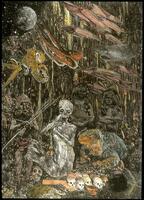
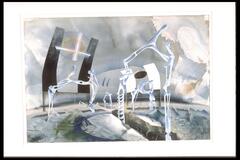
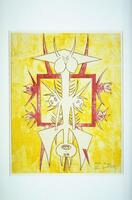

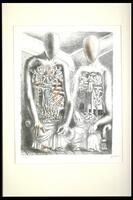

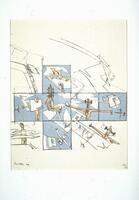
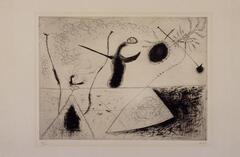
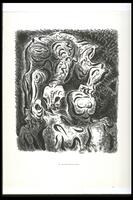
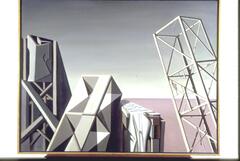

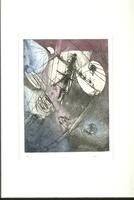


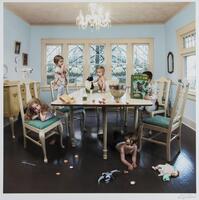
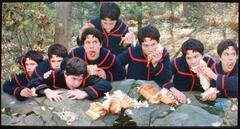
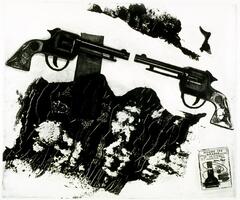
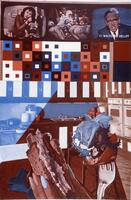
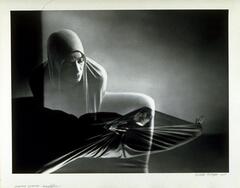
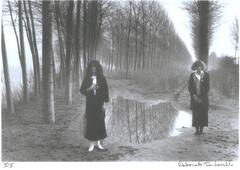

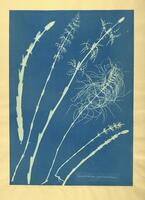
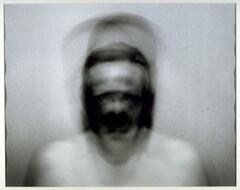
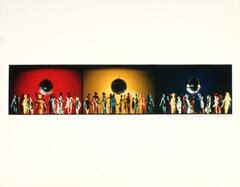


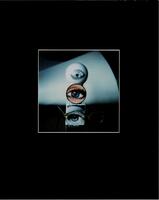

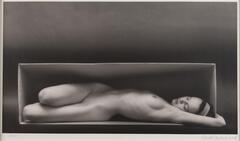
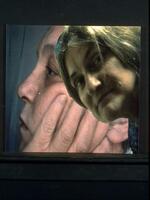
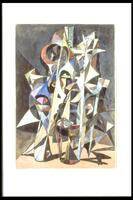
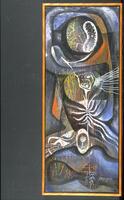
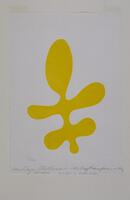

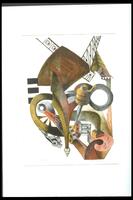
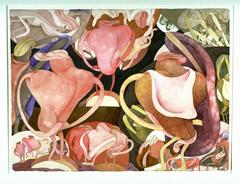
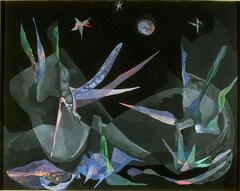

![A clear glass bubble rests on the bowl of a plain white clay pipe. Along the stem of the pipe are the words, "Ce que [sic] manque à nous tous." A clear glass bubble rests on the bowl of a plain white clay pipe. Along the stem of the pipe are the words, "Ce que [sic] manque à nous tous."](/media/W1siZiIsIjIwMjIvMDkvMjQvMmR5MHViN2o5Yl9kZWZhdWx0LmpwZyJdLFsicCIsInRodW1iIiwiMjQweDIwMCJdXQ?sha=e23a50659ff4d560)
